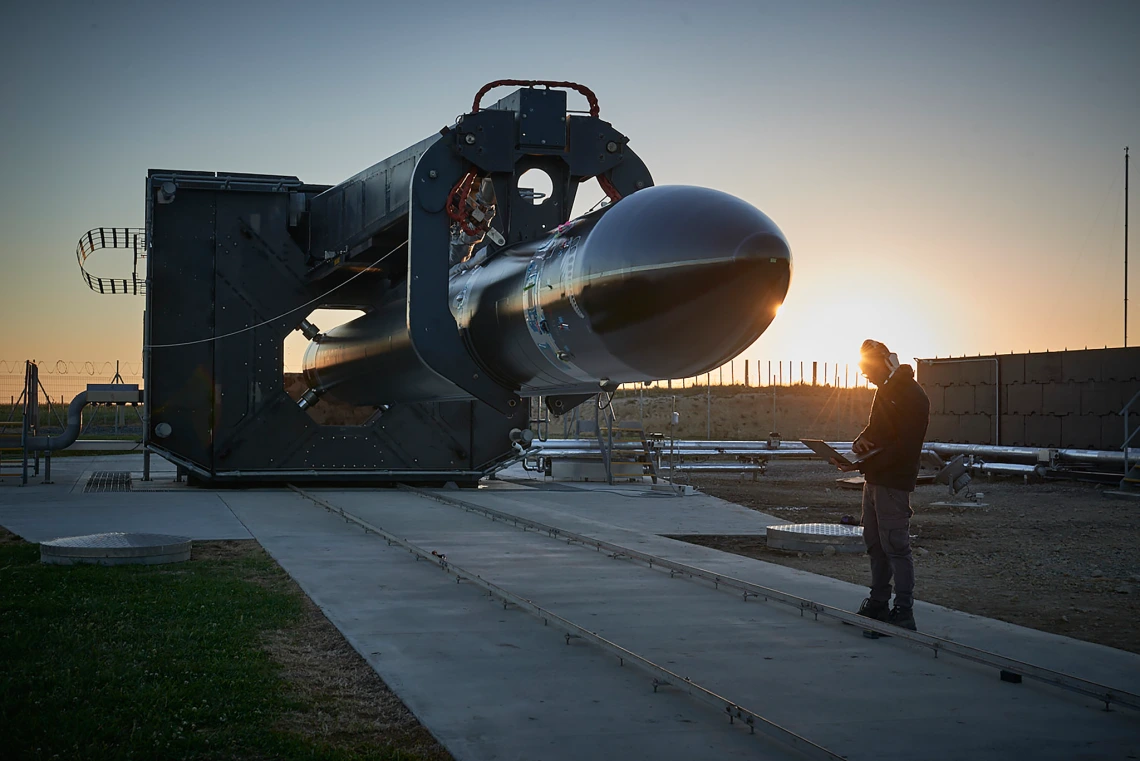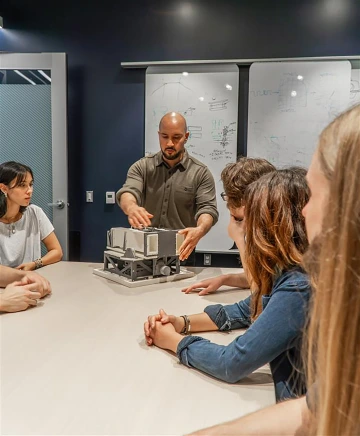Small Satellite, Big Search
A U of A-led NASA small-satellite mission called Aspera is investigating how galaxies are formed. It’s also quietly changing how missions of its kind might be conducted in the future.

Rocket Lab
In 2020, NASA announced an initiative called the Pioneers Program. The goal: to conduct compelling space science at lower cost using smaller hardware than similar missions in the past. Four missions were selected. Two of those missions are being led at NASA centers; two are being led at universities. Of the two being led at universities, only one will send a satellite into orbit. That mission, Aspera, is being led here, at the University of Arizona.
“U of A has been involved in NASA missions in the past,” says Carlos Vargas, the mission’s principal investigator and an assistant professor at the Steward Observatory. “NIRCam [the Near-InfraRed Camera on the James Webb Space Telescope], James Webb and such. But those were all managed elsewhere with involvement at U of A, or we’ve only managed the instruments. The whole kit and caboodle for Aspera is totally led and managed at the U of A. It’s really the first of its kind.”
Aspera’s goal is to study the diffuse matter surrounding galaxies, known as the circumgalactic medium, to see whether and how it contributes to the birth of stars and planets. “Gas is the fuel needed to make stars,” Vargas says. “We have a good understanding of how much gas there must be in galaxies to explain how many stars we see, but we’ve searched far and wide and still cannot find most of it.”

Principal Investigator Carlos Vargas with students, surveying a 3D-printed model of the Aspera telescope in the Applied Research Building.
Aspera team photo
The idea, Vargas explains, is that it might be somewhere in these peripheries. “Why do we care about that? Because every star that has formed, every planet that’s formed, and all life on those planets must come from matter somewhere.” Until now, Vargas says, astronomers have functionally just considered the gas “missing.” Aspera is looking for it. “Without it,” Vargas says, “we can’t truly understand our origins.”
Part of the mission’s novelty is its scale. Aspera is a small satellite, or SmallSat, a relatively recent step in the evolution of satellite design with the capacity to reduce both size and cost while still conducting meaningful science. (Imagine a mini fridge studded with solar panels, housing a Steward Observatory-designed telescope; this, roughly, describes what Aspera will launch into space.) “Ten years ago, launching an Aspera-sized payload would have cost $50 million to $100 million,” Vargas says; now, companies like SpaceX offer “rideshare” programs for small satellite payloads starting at $325,000.
Hardware and manufacturing have undergone similar shifts. “You don’t need to have your own electrical engineering lab that costs the university $50 million to build and run,” Vargas says. “You can buy off-the-shelf products instead” — military-grade and commercial spaceflight materials tested and modified for a mission’s specific needs. The image is of something scrappy, resourceful, less scientifically monolithic than the flagship missions of NASA’s past but nimble and dynamic in a way that suits space exploration’s rapidly developing present. Missions like the Hubble Space Telescope took 10, 20, 30 years; Aspera’s timeline is more like five.
The point isn’t just to save time or money but to expand the conversation about how science can be produced. “If we can prove that [Aspera] works, that effectively gives free rein to a huge slew of new people, new brains and new universities to be part of the space science process,” Vargas says. That might mean headier, more remote-seeming missions like Aspera, but it could also mean researchers in developing nations producing satellite imagery to help predict agricultural yields instead of relying on externally run satellites. “A mission like Aspera actually helps democratize access to space,” Vargas says. “That’s kind of pie-in-the-sky, but it would inevitably lead from proving that small satellites can have a huge impact.”
The project also has offered opportunities to student workers — 37 so far — who, Vargas says, go way beyond the norm. “Our flight software is entirely built by students. They design it all, they test it all, they write it all. Of course, we have people to support and mentor them,” he says, including astronomy professor and deputy principal investigator Erika Hamden. “But at the end of the day, it gives them real experience.”
Some have gone on to work at places like Amazon and Raytheon; others, like Ellie Wolcott, have continued in research. “My first day on the Aspera mission was actually my last day of high school,” says Wolcott, now a research engineer at Georgia Tech. “That’s four full years of working on a space mission — an experience I don’t think many of my classmates had.”
But for Sooseong Park, the most remarkable part of the work was being treated like a peer. “If my opinion seemed efficient, colleagues would accept my suggestions and apply them,” she says. “I truly felt like I was part of this field.” ❖
